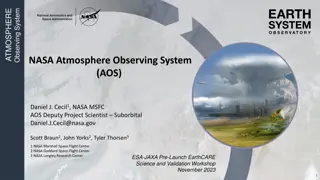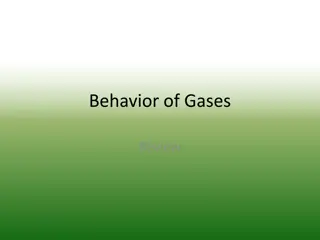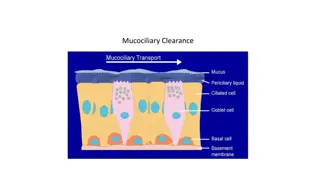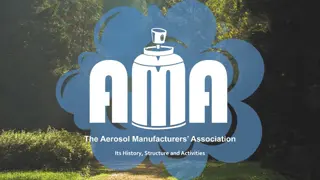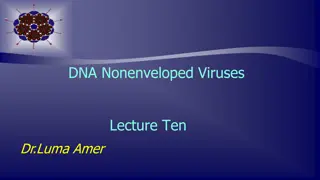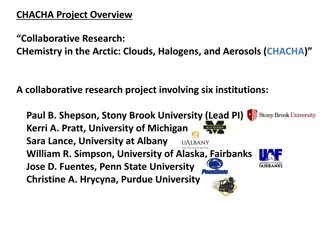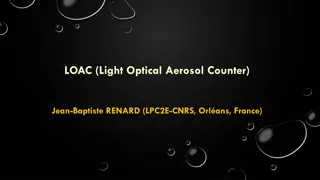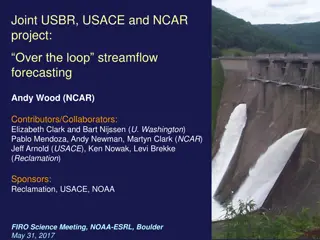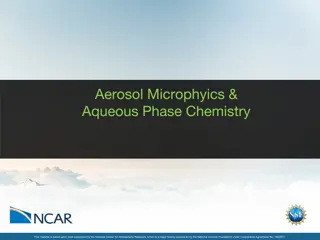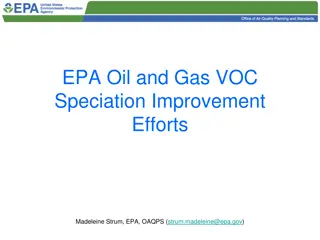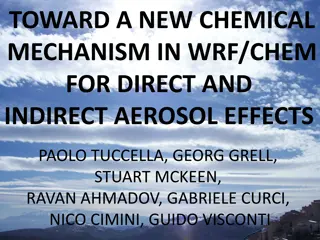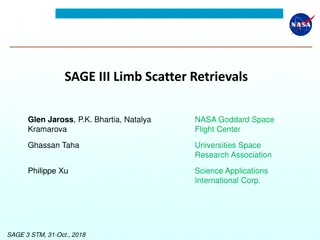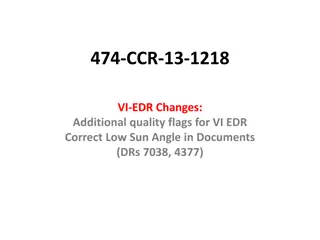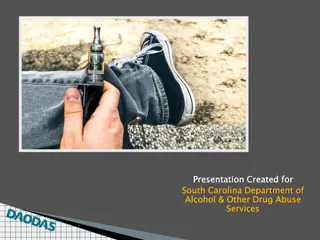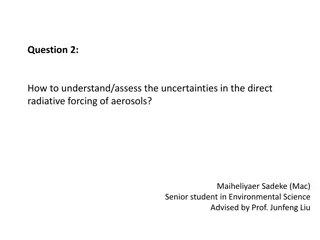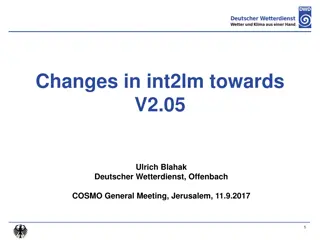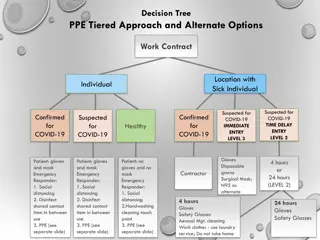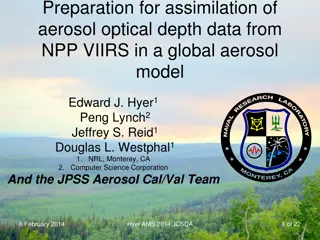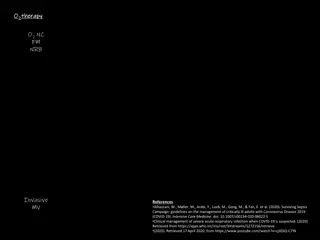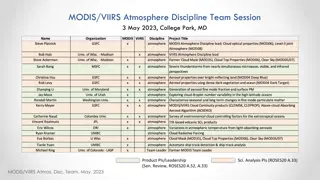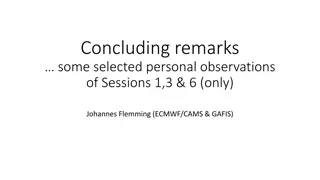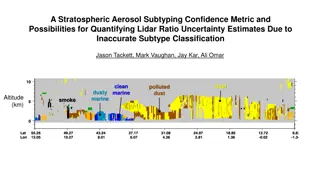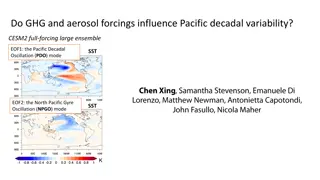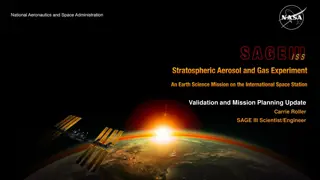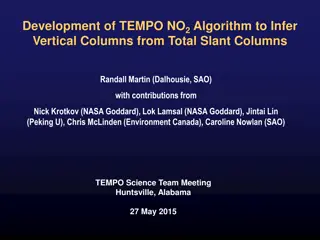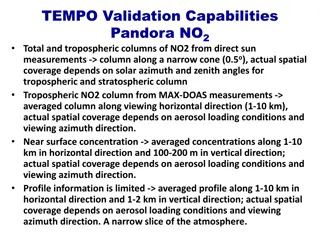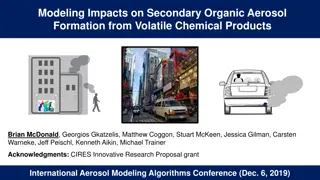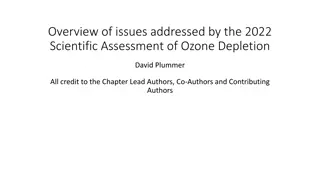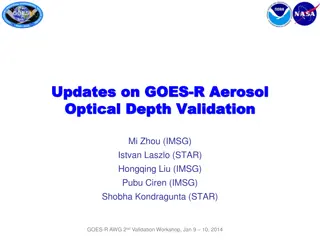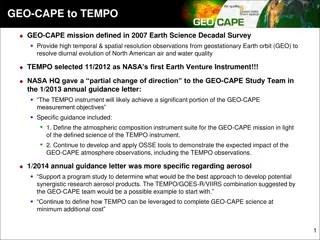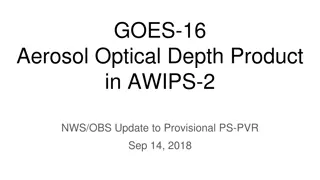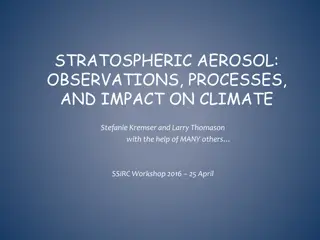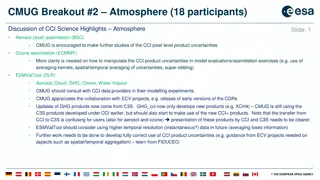NASA Atmosphere Observing System (AOS) Overview
NASA's Atmosphere Observing System (AOS) comprises innovative technologies and instruments to study aerosol, cloud, convection, and precipitation processes. AOS includes the AOS-Storm and AOS-Sky missions, utilizing various sensors like radars, lidars, radiometers, and polarimeters to address key at
1 views • 13 slides
Gas Behavior Review
Review key concepts related to the behavior of gases, including characteristics of gases, properties at standard conditions, the kinetic molecular theory, and factors affecting gas pressure. Test your knowledge with true or false questions and learn about gas compression, gas movement in aerosol can
1 views • 17 slides
Aerosol Can Market Current Status and Future Prospects By 2024
Global Aerosol Can Market Breakdown by Application (Personal Care, Household, Automotive & Industrial, Food, Paints, Medical) by Type (Bag-on-valve (BOV), Standard) by Can Type (Steel, Aluminum, Plastic) and by Geography (North America, South America
0 views • 8 slides
Respiratory Health Imaging Studies and Evaluation
Explore a series of informative images showcasing various respiratory health evaluations and studies, including mucociliary clearance, cough clearance measured by gamma scintigraphy, pulmonary deposition of inhaled aerosol therapies, and assessment of fitted filtration efficiency using specialized p
1 views • 5 slides
Aerosol Manufacturers' Association South Africa Overview
The Aerosol Manufacturers' Association (AMA) of South Africa, founded in 1963, aims to improve regulatory and safety standards in the aerosol industry. It conducts activities such as hosting an Annual General Meeting, electing an Executive Committee, and emphasizing on Anti-Trust obligations. AMA st
0 views • 12 slides
Adenoviruses: Structure, Replication, and Epidemiology
Adenoviruses, known for causing respiratory infections, have at least 41 serotypes categorized into 6 subgenera. Their structure includes 252 capsomeres, 240 hexons, and specific proteins for attachment. The replication involves virus attachment, penetration, uncoating, and transportation of viral D
0 views • 22 slides
GOES-18 Provisional Validation Review and Products Overview
Peer and stakeholder validation review of GOES-18 Group 3 products including land surface temperature, aerosol optical depth, aerosol detection products for dust and smoke, and rain rate/quantitative precipitation estimate. Data presented in non-operational format with discussions on wintertime use
0 views • 8 slides
Chemistry in the Arctic: CHACHA Project Overview
The CHACHA Project is a collaborative research initiative involving six institutions to study Arctic chemistry in relation to sea ice loss and fossil fuel extraction. The team aims to assess how these environmental changes impact halogen, nitrogen, and sulfur chemistry, with a focus on aerosols and
0 views • 6 slides
Light Optical Aerosol Counter (LOAC) Project Overview
Light Optical Aerosol Counter (LOAC) is a project led by Jean-Baptiste Renard in France, involving a collaboration between research institutions, private companies, and the French Space Agency. The LOAC instrument, weighing 1 kg, is used with meteorological balloons to measure concentrations of aero
0 views • 21 slides
Cutting-Edge Atmospheric Chemistry Modeling Research at Barcelona Supercomputing Center
Conducted by the Atmospheric Composition Group at Barcelona Supercomputing Center, this cutting-edge research focuses on atmospheric chemistry modeling using advanced tools and frameworks like HERMESv3 and MONARCH. The team's approach integrates various modules to study complex processes influencing
0 views • 16 slides
Radiative Forcings in Climate Dynamics
Climate forcings directly impact global temperature by changing solar energy absorption and greenhouse gas concentrations. Shortwave forcings involve changes in solar radiation absorbed, while longwave forcings relate to greenhouse gases affecting the greenhouse effect. Positive radiative forcings l
1 views • 36 slides
Over-the-Loop Streamflow Forecasting Project Summary
Joint project by USBR, USACE, and NCAR focusing on improving streamflow forecasting using automated over-the-loop approaches. Key challenges include model calibration, data assimilation, and real-time forcings. Objectives involve building an automated system for short- to long-term flow predictions
0 views • 41 slides
Aerosol Microphysics and Aqueous Phase Chemistry in Atmospheric Research
This material delves into the study of aerosol microphysics and aqueous phase chemistry in the context of atmospheric research. It discusses topics such as scale-dependencies, obstacles in development, working groups for MUSICA, and the importance of various processes in aerosol modeling. The conten
0 views • 11 slides
EPA Oil and Gas VOC Speciation Improvement Efforts
EPA's VOC Speciation transforms inventory species into Air Quality model species to support chemistry, ozone, and aerosol chemistry. The Speciate4.5 update in 2016 added oil and gas profiles, including location-specific uncontrolled profiles and WRAP profiles for various basins. The Uinta TMSR profi
2 views • 10 slides
Advancements in Chemical Mechanisms for Aerosol Effects in WRF/Chem Model
This study focuses on the development of a new chemical mechanism in the Weather Research and Forecasting with Chemistry (WRF/Chem) model to address the underestimation of carbonaceous aerosols. The RACM/MADE/SOA-VBS mechanism incorporates advancements in gas-phase chemistry and particle parameteriz
0 views • 12 slides
Advanced Analysis of SAGE III Limb Scatter Retrievals
The proposed effort focuses on enhancing LaRC operational retrieval codes for SAGE LS data, correcting Level 1 radiances, and recommending LS operational scenarios. OMPS LS retrieval algorithms for aerosol and ozone, as well as the SAGE/M3 LS ozone retrieval approach, are detailed. Out-of-field stra
0 views • 12 slides
GOES-R ABI Aerosol Detection Product Validation Summary
The GOES-R ABI Aerosol Detection Product (ADP) Validation was conducted by Shobha Kondragunta and Pubu Ciren at the NOAA/NESDIS/STAR workshop in January 2014. The validation process involved testing and validating the ADP product using proxy data at various resolutions for detecting smoke, dust, and
1 views • 21 slides
Enhancements to VI EDR Quality Flags and Documentation Correction
Recommended additional quality flags for VI EDR include Adjacency Clouds, Cloud Shadows, Snow/Ice, and Aerosol Quantity to screen suspicious pixels. With these new QFs and implementation of DR 4488, confident cloud check to be removed. Documentation updates also include correcting low sun angle thre
0 views • 10 slides
Vaping Awareness Presentation for South Carolina Department of Alcohol & Other Drug Abuse Services
This presentation for the South Carolina Department of Alcohol and Other Drug Abuse Services focuses on educating educators, schools, and parents about vaping trends, youth vaping dangers, state-specific information, and resources available for parents and professionals. It covers topics such as wha
0 views • 37 slides
Uncertainties in Direct Radiative Forcing of Aerosols
The uncertainties in the direct radiative forcing of aerosols can be assessed by considering factors such as emissions, lifetime, Mass Absorption Cross Section (MAC), Aerosol Absorption Optical Depth (AAOD), and forcing efficiency. Variations in these factors contribute to the overall uncertainty in
0 views • 9 slides
Update Summary of Changes in int2lm Version 2.05 by Ulrich Blahak (2017)
Changes in int2lm towards version 2.05 presented by Ulrich Blahak at the COSMO General Meeting in Jerusalem include modifications to non-hydrostatic input models (COSMO, ICON, UM) with bug fixes and method improvements affecting pressure computation, soil temperature adaption, and vertical profile a
0 views • 33 slides
COVID-19 PPE Tiered Approach and Alternate Options for Work Contracts
This comprehensive guide outlines a tiered approach for Personal Protective Equipment (PPE) and alternate options for individuals suspected or confirmed with COVID-19 in work contract settings. It includes detailed instructions for different scenarios, such as immediate entry, time delay entry, and
0 views • 8 slides
Assimilation of NPP VIIRS Aerosol Optical Depth Data in Global Model
Preparation and assimilation of aerosol optical depth data from NPP VIIRS into a global aerosol model, including product descriptions, data requirements, processed observations, and conclusions on VIIRS aerosol products. Details on AOT, APSP, SM classification, and environmental data records are cov
0 views • 19 slides
Clinical Management Guidelines for Critically Ill Adults with COVID-19
The guidelines focus on managing severe acute respiratory infections suspected to be COVID-19, covering oxygen supplementation starting recommendations, SpO2 targets, use of HFNC and NIPPV, risk of aerosol transmission, initial ventilator settings, troubleshooting, and the transition to invasive mec
0 views • 8 slides
MODIS/VIIRS Atmosphere Discipline Team Session - May 2023, College Park, MD
The MODIS/VIIRS Atmosphere Discipline Team hosted a session in May 2023 at College Park, MD, focusing on various aspects of atmospheric science. The session included presentations on aerosols, clouds, data access, continuity products, and new science products. Speakers discussed topics such as ambie
0 views • 4 slides
Advances in Operational Air Quality Forecasting and Data Assimilation
Key observations and advancements in operational air quality forecasting and data assimilation were highlighted in sessions featuring prominent experts from various organizations like ECMWF/CAMS, GAFIS, NOAA, and ECCC. Topics discussed ranged from progress and challenges in air quality forecasting i
0 views • 12 slides
Stratospheric Aerosol Subtyping Confidence and Lidar Ratio Uncertainty
This research delves into the classification confidence of stratospheric aerosol subtypes and possibilities for quantifying uncertainties in lidar ratio estimates due to inaccurate classification. It discusses CALIOP initial aerosol lidar ratios, optical properties of stratospheric aerosol layers, c
0 views • 15 slides
Influence of GHG and Aerosol Forcings on Pacific Decadal Variability in CESM2
The study investigates how greenhouse gas (GHG) and aerosol forcings impact Pacific decadal variability (PDV) through the analysis of CESM2 full-forcing large ensemble data. It explores the influence on the Pacific Decadal Oscillation (PDO) and North Pacific Gyre Oscillation (NPGO) modes, long-term
0 views • 5 slides
SAGE III Validation Update: Mission Planning, Partnerships, and Criteria
Carrie Roller, the SAGE III Scientist/Engineer, provides an update on validation and mission planning, including partnerships with NDACC lidar and sonde sites, weekly coordination of SAGE III events with in-situ data, and the criteria for validation using in-situ data such as stratospheric ozone, ae
0 views • 13 slides
Developments in Vertical Columns Inference for TEMPO NO2 Algorithm
The development of the TEMPO NO2 algorithm to infer vertical columns from total slant columns involves contributions from various experts, such as Randall Martin, Nick Krotkov, Lok Lamsal, Jintai Lin, Chris McLinden, and Caroline Nowlan. Attention is needed for the removal of stratospheric NO2 and a
2 views • 10 slides
Pandora Advanced Validation Capabilities for NO2 Monitoring
Pandora advanced validation capabilities for NO2 monitoring involve measurement techniques such as Total and Tropospheric columns of NO2 through direct sun and MAX-DOAS methods, with emphasis on spatial coverage dependent on various factors. The system provides real-time near-surface concentrations,
0 views • 6 slides
GEOS-Chem Atmospheric Chemistry Model Overview
GEOS-Chem, developed by Daniel J. Jacob at Harvard University, is a global model of atmospheric composition used to understand human and natural influences on the environment. The model addresses various atmospheric chemistry issues on different scales, from local to global, and is regularly updated
0 views • 19 slides
Secondary Organic Aerosol Formation from Volatile Chemical Products
This research explores the impacts of volatile chemical products (VCPs) on secondary organic aerosol (SOA) formation. By identifying chemical tracers, assessing VCP contributions, and analyzing VOC emissions in different cities, the study aims to enhance our understanding of air quality and sources
0 views • 16 slides
Insights from 2022 Scientific Assessment of Ozone Depletion
The 2022 Scientific Assessment of Ozone Depletion, led by David Plummer, addresses key issues like Ozone Depleting Substances, HFCs, Global and Polar Stratospheric Ozone, Climate Impacts, Stratospheric Aerosol Injection, and more. Chapter details reveal decreasing trends in Ozone Depleting Substance
0 views • 12 slides
Updates on GOES-R Aerosol Optical Depth Validation Activities
Generated proxy data algorithm enhancements for post-launch validation activities were discussed at the GOES-R AWG 2nd Validation Workshop in January 2014. The use of MODIS reflectances as a proxy for ABI to retrieve Aerosol Optical Depth (AOD) was emphasized, along with the importance of AERONET gr
0 views • 25 slides
Near-UV Satellite Observations for Retrieving Aerosol Properties
Near-UV satellite observations offer a valuable method for retrieving aerosol properties, including aerosol optical depth, absorption, layer height, and surface albedo. These observations provide advantages like sensitivity to aerosol properties and negligible gas absorption interference. However, c
0 views • 16 slides
Evolution of GEO-CAPE: Leveraging TEMPO for Atmospheric Observations
The GEO-CAPE mission, defined in the Earth Science Decadal Survey of 2007, aims to provide high-resolution observations from geostationary Earth orbit to monitor North American air and water quality. NASA's TEMPO instrument, selected in November 2012, plays a crucial role in achieving GEO-CAPE's obj
0 views • 5 slides
Overview of GOES-16 Aerosol Optical Depth Products and SoCal/Baja Weather Conditions
This content provides information on various products derived from the GOES-16 satellite, including aerosol optical depth measurements in different sectors and menus available. It also includes weather conditions in the Southern California/Baja region on September 9, 2018, as reported by the Phoenix
0 views • 7 slides
STRATOSPHERIC AEROSOL: OBSERVATIONS, PROCESSES, AND IMPACT ON CLIMATE
The world of stratospheric aerosols, their role in climate, and the latest advancements in observation techniques and processes. Dive into the intricate details of aerosol life cycles and learn about the significant findings of studies spanning from 2006 to recent reviews. Uncover the differences in
0 views • 17 slides
CCI Science Highlights: Uncertainties and Model Evaluations
Discussion at the CMUG Breakout session on atmosphere science highlights from the CCI, focusing on aerosol and ozone assimilation, product uncertainties, collaboration with ECV projects, and transitioning from CCI to C3S. Recommendations include the need for clearer presentation of products, utilizi
0 views • 7 slides
